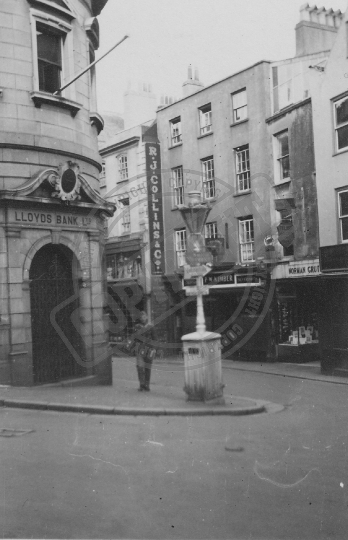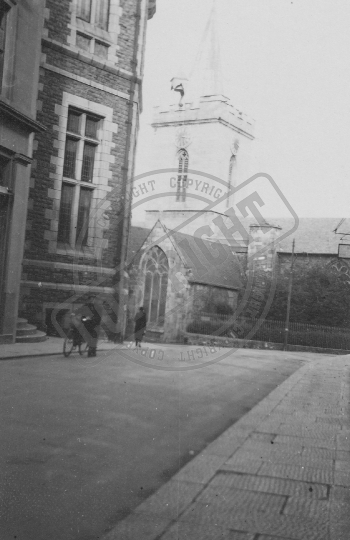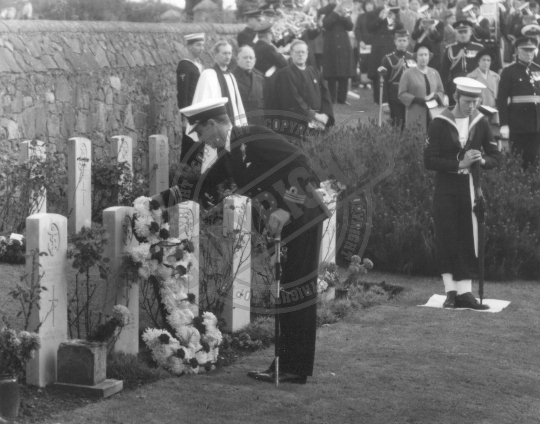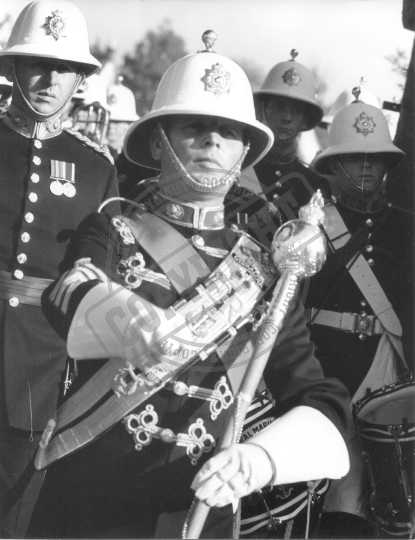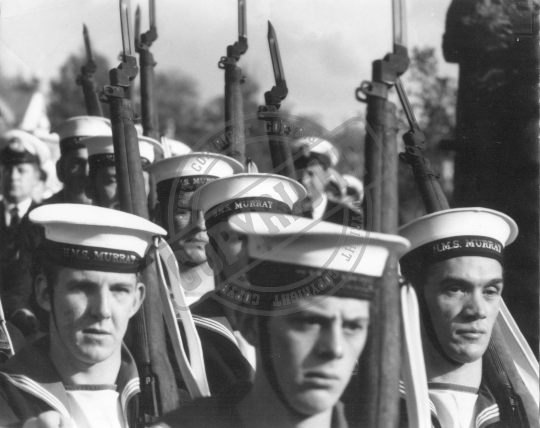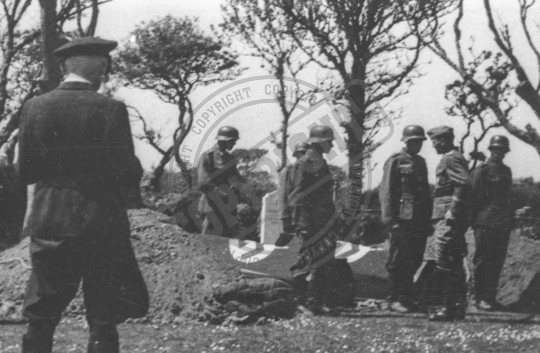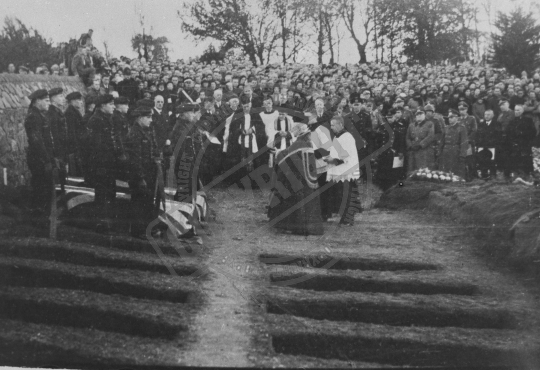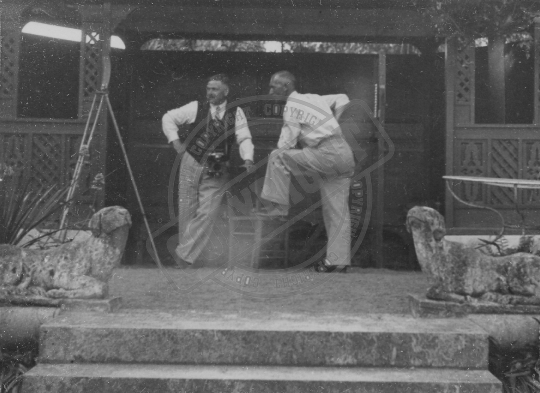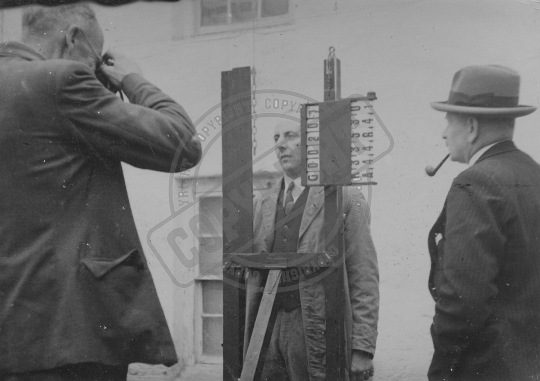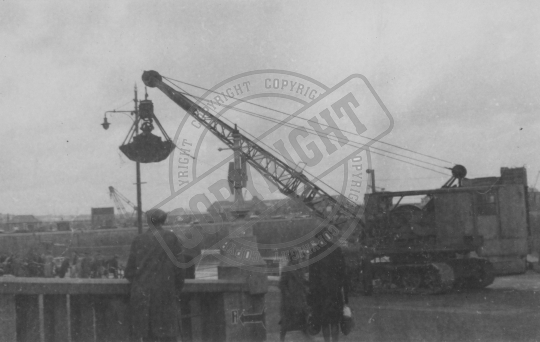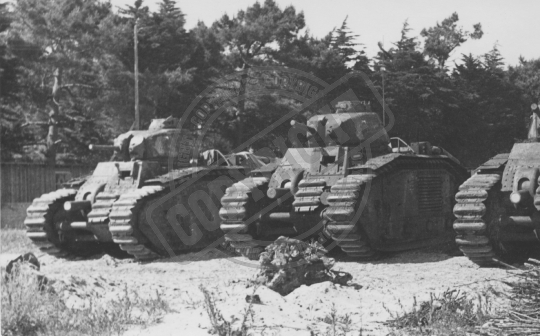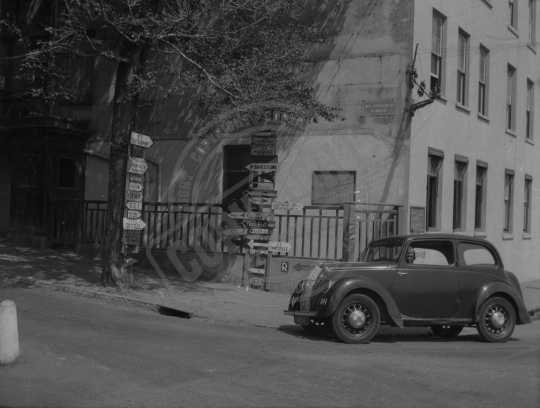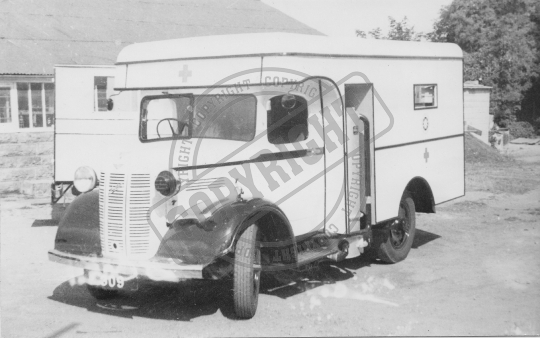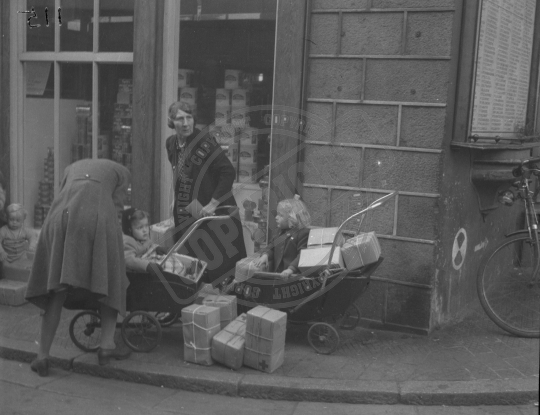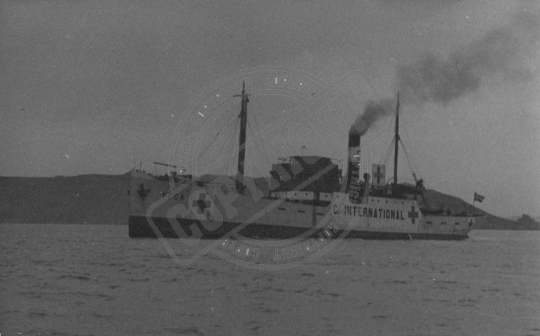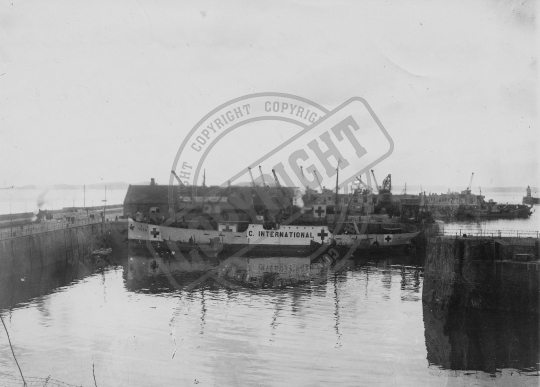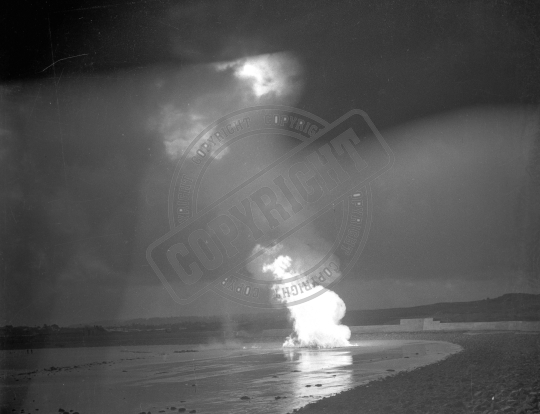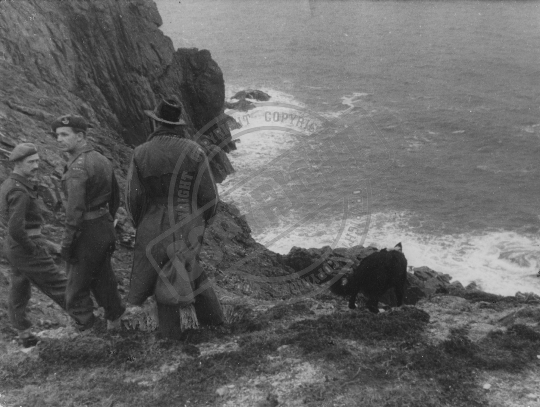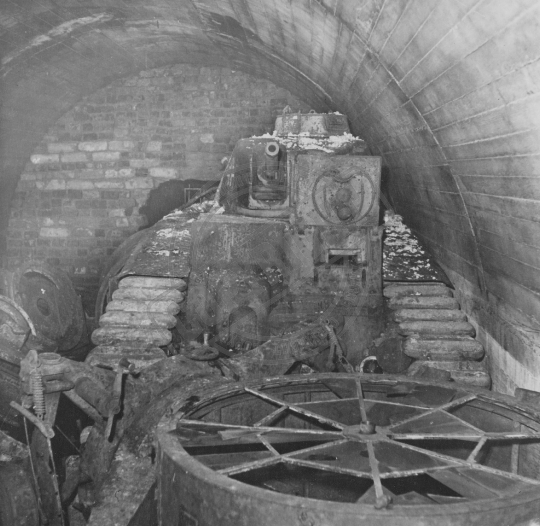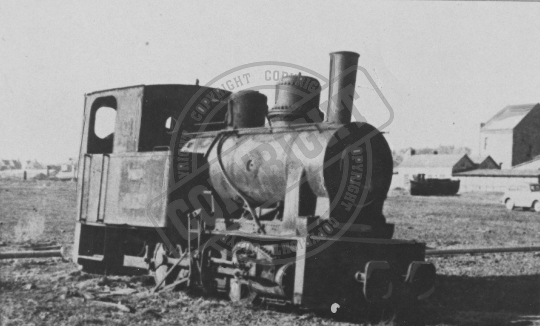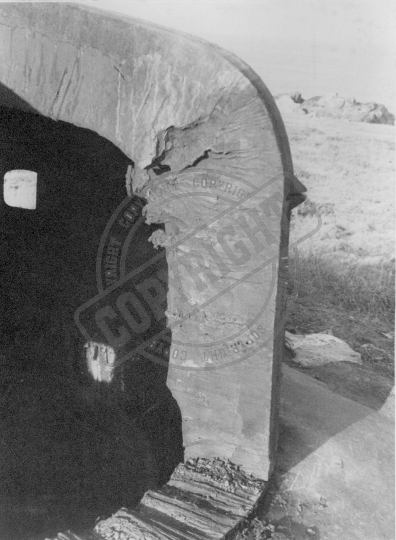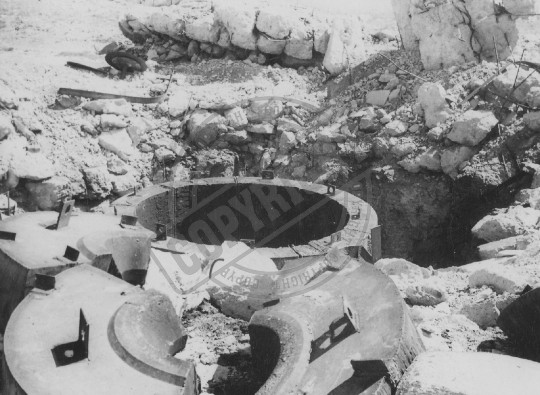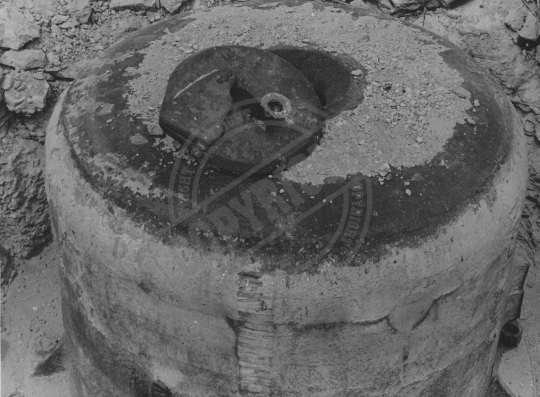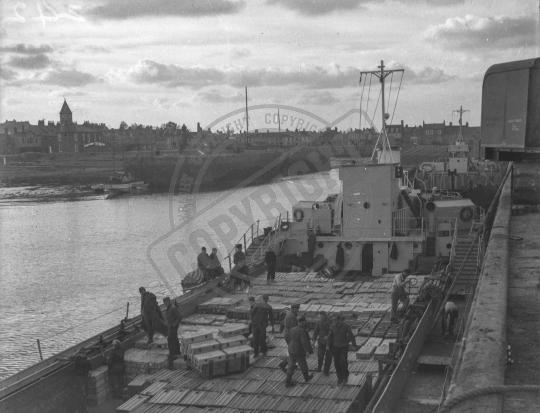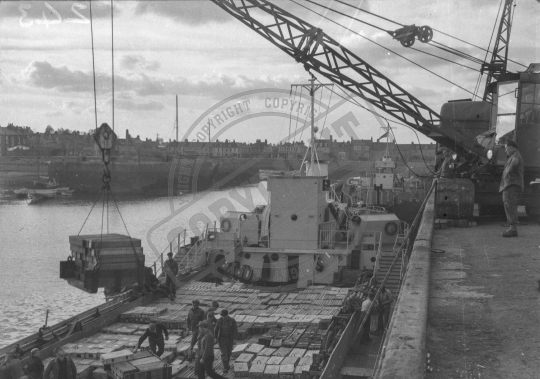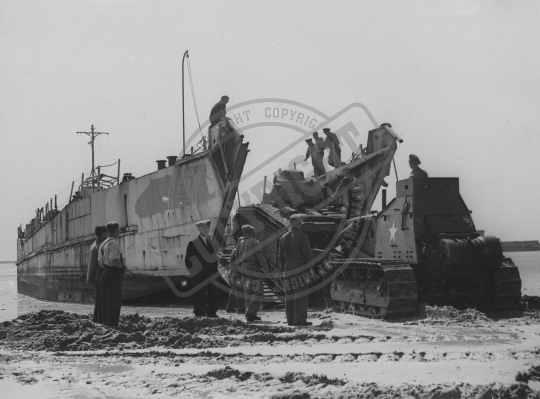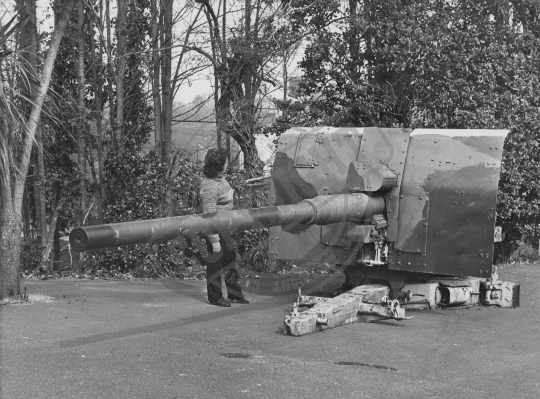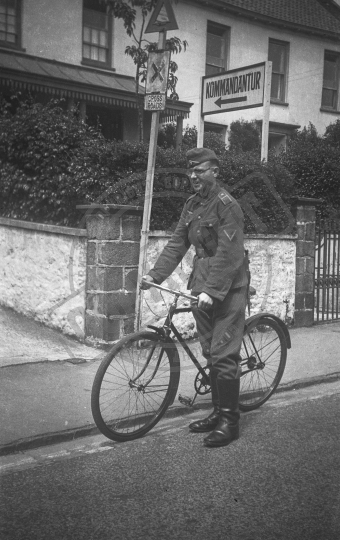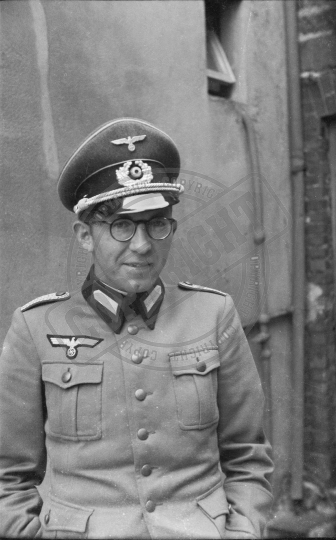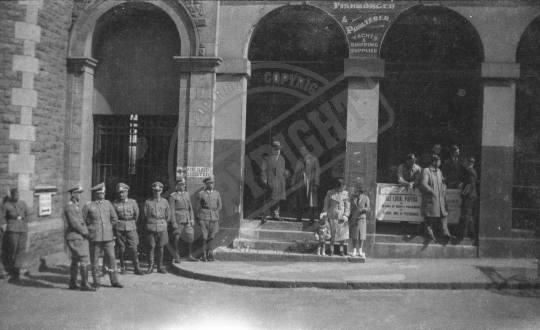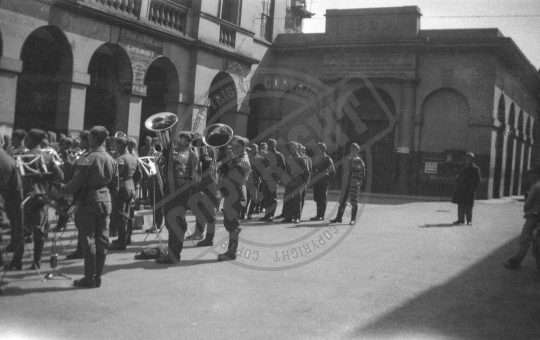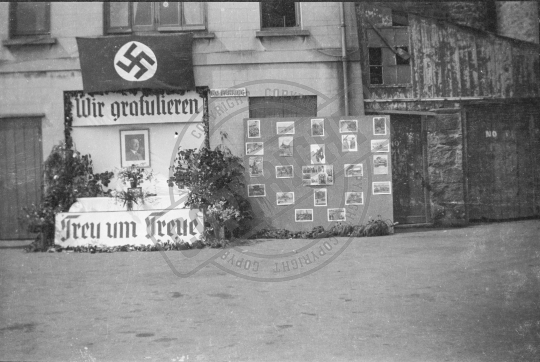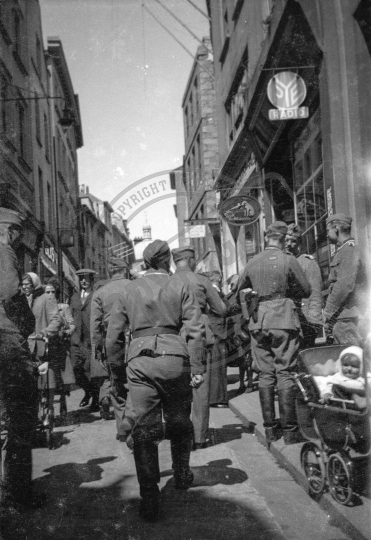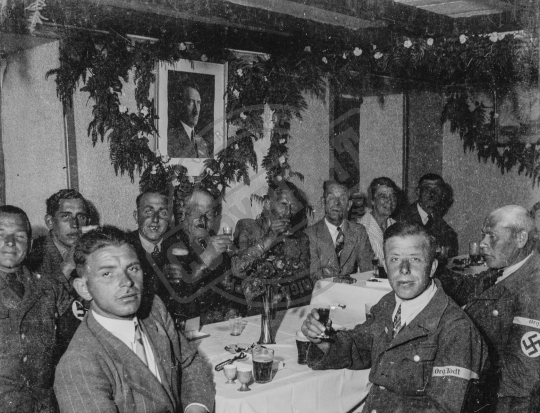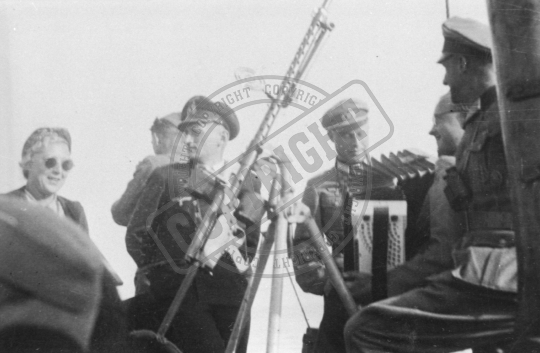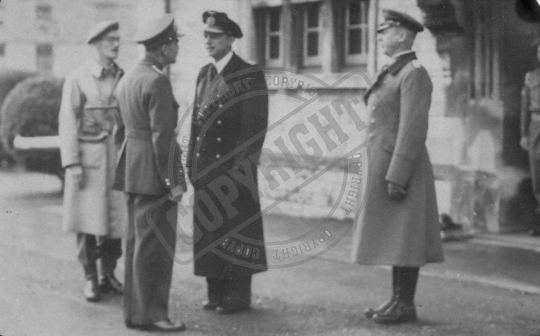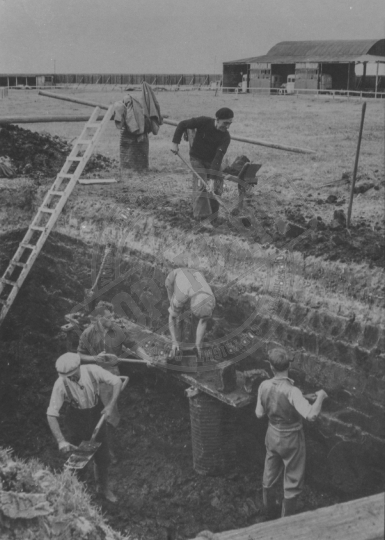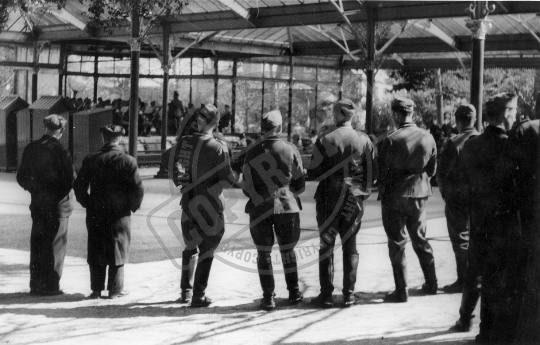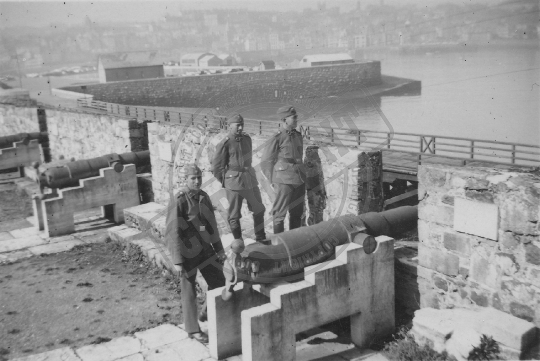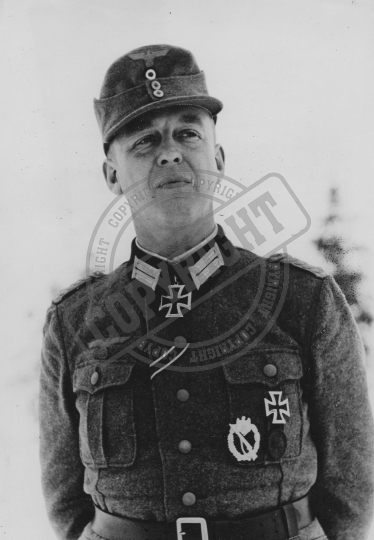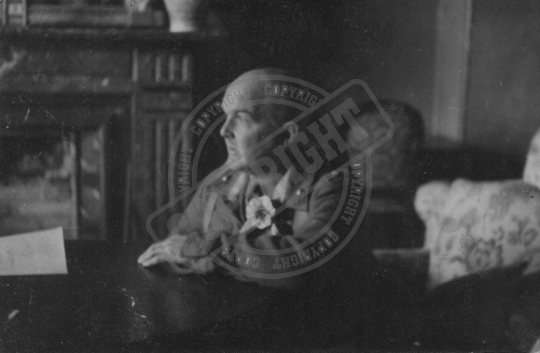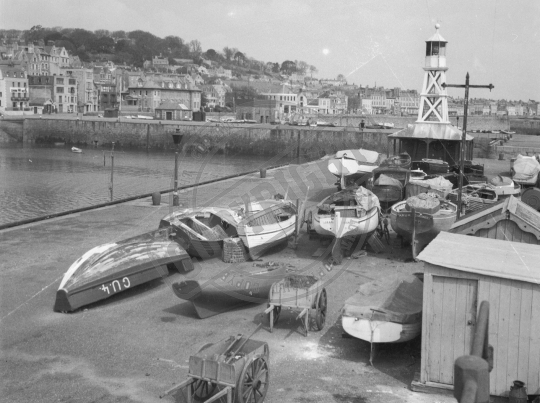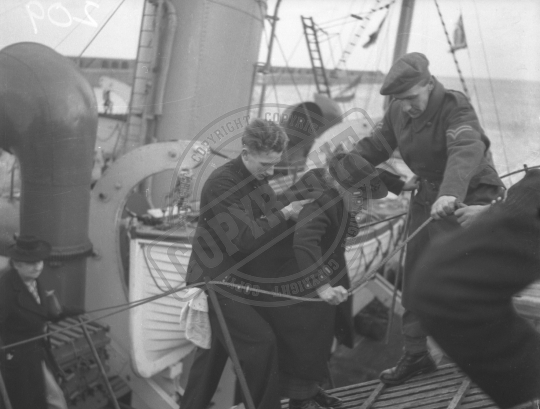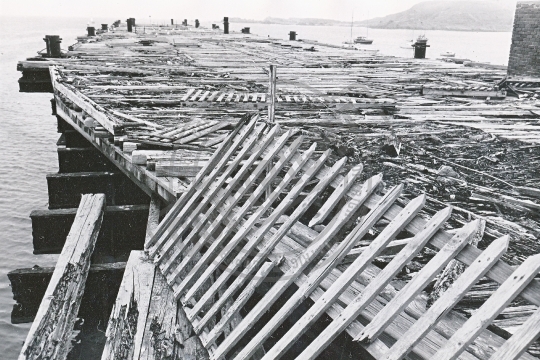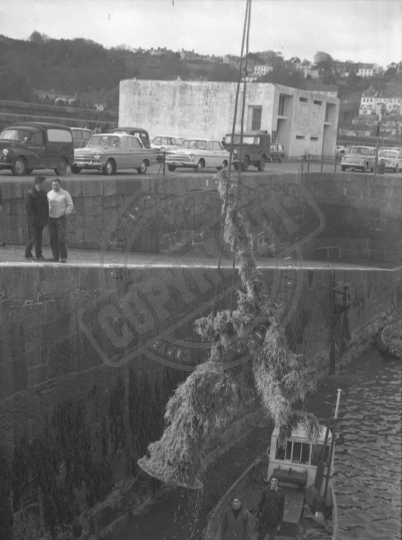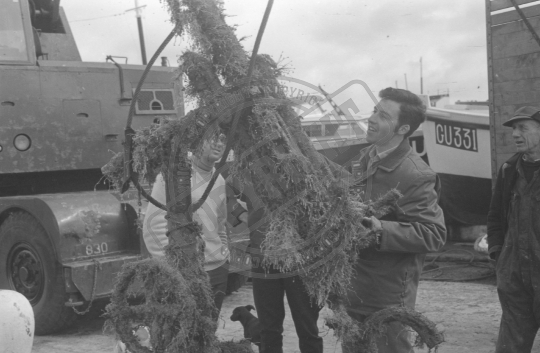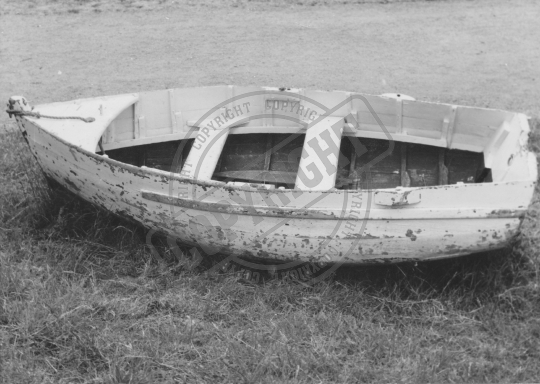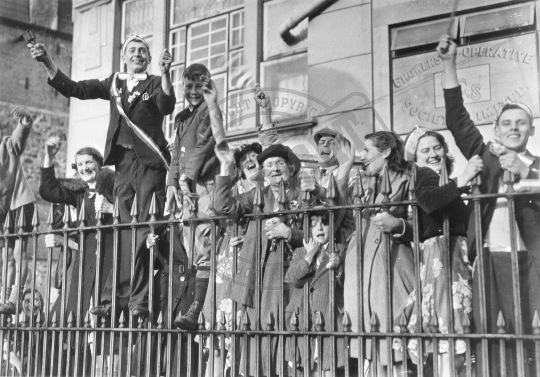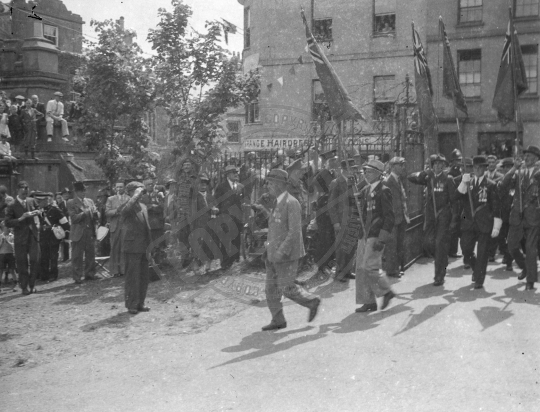Results (296)
OA_089
A typical stop for German troops seeking propaganda photographs featuring British institutions here outside Lloyds Bank located at the foot of Smith Street leading to the Pollet.
OA_088
At the foot of Fountain Street civilians are photographed going about their business, note the cyclist making their way up the road keeping to the right hand side.
TPL_00164
Two soldiers who were killed when clearing their own mines immediately after the occupation are buried in the cemetery near St Peters church in Sark.
TPL_00162
Funeral service for Royal Navy victims of HMS Charybdis and HMS Limbourne who were buried with full military honours at Le Foulon Cemetery.
TPL_00178
The "photo-census" in progress in the summer of 1941. Charles Toms is shown photographing a subject, with reference number displayed on an easel.
TPL_00380
Heavy construction equipment was used during the building of the fortifications, this crane with fitted with a grab was used during the excavation process. Photographed at the top of the slipway next to the Albert statue, note the road sign painted at the foot of the wall and the 'Antee’ floating crane seen in the background.
TPL_00326
French Char bis B1 tanks used by the Germans awaiting shipment from Millbrook, Jersey to France 29th May 1945.
TPL_00322
As the military buildup increased, so did the number of road signs directing German forces to them. Many roads were thoroughly signposted like this example at the bottom of St Julian's Avenue, Guernsey. Note the Guernsey Press Censor in his car.
TPL_00323
This cut down furniture van was transformed into a very efficient ambulance which ran on charcoal gas and was ready for service by September 1942.
TPL_00312
The arrival of the Swedish ship SS Vega chartered by the International Red Cross to bring food and supplies to the starving islanders did much to alleviate the suffering of the civilians. Here Red Cross parcels were distributed to the islanders at Les Riches, St Peter Port.
OA_074
The Swedish ship SS Vega, chartered by the International Red Cross to take Red Cross Supplies to the Channel Islands. She is seen here off St Aubin’s Bay after leaving St Helier Harbour on Friday, 11th May, 1945.
OA_014
The Swedish ship SS Vega, chartered by the International Red Cross to take Red Cross Supplies to the Channel Islands, at the London Berth, St Peter Port Harbour, Guernsey. Note German FK vessels moored alongside and trains on the quay.
TPL_00310
Cordite being burnt on the beach in Guernsey 1945, the photographer could feel the heat from over 400 feet away.
OA_067
Major F. Sargent, Lt-Col Rogers and an Evening Post reporter at Les Landes, 1946. The cliffs at Les Landes, St Ouen, Jersey are sheer and over 200 feet high. These were chosen as the most suitable site for dumping all the German medium and heavy coastal artillery pieces.
TPL_00370
A French Char B1-bis tank in one of the German chambers of the tunnel now converted into the Aquarium. These were captured tanks brought to the islands by the Germans as part of Panzer unit 216. The tank was photographed prior to its removal in 1952.
TPL_00367
The Germans installed a railway network to move food and materials around the island, these were used extensively during the construction of the fortifications. This derelict locomotive lies in St Sampson along Bulwer Avenue prior to being scrapped.
TPL_00365
An armoured steel turret at Fort Doyle during the post war scrap metal drive, workers used gas axes and thermal lances to cut through the enormous steel sections.
TPL_00363
The M19 armoured turret at Fort Hommet has been cut into manageable pieces ready for transport to the United Kingdom as scrap metal.
TPL_00362
The steel armoured turret of the M19 automatic mortar at Fort Hommet prior to the scrap men cutting it up and being made ready to be transported to the United Kingdom as scrap metal.
TPL_00359
Shortly after Liberation the massive task of clearing ammunition began. The majority of the ammunition was loaded aboard LCTs by German PoW s and taken to the eastern end of Hurd Deep where the water is some 550 feet deep. This image shows the loading of ammunition at Northside, Vale.
TPL_00358
Shortly after Liberation the massive task of clearing ammunition began. The majority of the ammunition was loaded aboard LCTs by German POWs and taken to the eastern end of Hurd Deep where the water is some 550 feet deep. This image shows the loading of ammunition at Northside, Vale.
OA_069
The last of the French Char B1 tanks is loaded onto a Landing Craft Tank (LCT), at La Haul Slip, St Aubin’s Bay, Jersey on the 17th May, 1946. These tanks had been captured by the Germans and formed Panzer Abteilung 213 that was stationed in the island. They were returned to France and the French Army.
TPL_00305
8.8cm Flak 41 anti-aircraft gun on display at the German Occupation Museum in the 1980`s. Weapons of this model were never installed in the Channel Islands.
TPL_00304
8.8cm Flak 41 anti-aircraft gun on display at the German Occupation Museum in the 1980`s. Weapons of this model were never installed in the Channel Islands.
TPL_00374
A German NCO outside the Kommandantur Office in Jersey with one of the bicycles that were requisitioned during the occupation under Article 53 of the Hague Convention despite considerable protests.
TPL_00353
The press censor Sonderfuehrer Kurt Goettmann appointed on the 27th January 1942 at the age of 32. His previous experience included working in press offices in both Paris and London. The censor role was to ensure that anything published followed the stringent rules set out by the Germans.
TPL_00302
German officers listen to a band playing in Market Square, St Peter Port. Note the air raid shelter sign on the wall.
TPL_00294
German forces made a mad rush for the well stocked shops in the early days of the occupation. Here we see both Germans and civilians in the High Street, St Peter Port, Guernsey.
TPL_00281
German personnel and their guests on the way to the Casquets for an outing in the summer of 1941.
TPL_00276
Vizeadmiral Fredrich Hueffmeir and Generalmajor Rudolf Wulf are seen here after the German surrender when they arrived in Plymouth on 12th May 1945.
TPL_00265
In 1940 it was soon evident there would be a shortage of domestic fuel so many tons of peat were dug from a bog at Vazon in Guernsey and St Ouen`s Bay in Jersey.
SP_0004
Germans stand alongside one of the cannons of Castle Cornet in St Peter Port. The Castle was the 'Hafenschlosss' (harbour Castle) during the occupation of Guernsey by German forces from 1940 until 1945. The occupying forces built air raid shelters and platforms for anti aircraft-guns to update the Castle for 20th century warfare.
OA_063
Generalmajor Rudolf Wulf who was the Festungskommandant Jersey at liberation seen here after the award of his Knight’s cross of the Iron Cross, on 12th January 1943. At the time he was an Oberstleutnant (Lieutenant-Colonel) in charge of an infantry regiment.
OA_033
Guernsey, 9th May 1945. Colonel H. R. Power, OBE, MC (late Glosters), Chief civil affairs Officer (CCAO), No. 20 Civil Affairs Unit, HQ Guernsey, Force 135.
TPL_00254
Fishing boats laid up at the Old Harbour, St Peter Port, following the order for all boats to be moved to main harbours.
TPL_00252
Mrs Bessie Duplain disembarking from SS Autocarrier on her return to Alderney in December 1945.
TPL_00251
The German jetty at Braye Harbour, Alderney in advanced stages of decay. The jetty comprised of two Krupp sections linked to a Dortmunder Union section which in turn was connected to the existing harbour. The jetty was designed for use as an improvised harbour during Operation Sealion. It was finally demolished in 1979.
TPL_00250
20mm anti-aircraft gun salvaged in April 1969 by Mr Len Mecham and his crew of divers from the wreck of the VP209 'Dr. Rudolph Wahrenorff'. On cleaning the barnacles from the remains of the magazine five 20mm rounds were revealed.
TPL_00246
20mm anti-aircraft gun salvaged in April 1969 by Mr Len Mecham and his crew of divers from the wreck of the VP209 'Dr. Rudolph Wahrenorff'. On cleaning the barnacles from the remains of the magazine five 20mm rounds were revealed.
TPL_00244
The 8-foot dinghy in which Dennis Vibert escaped from Jersey to England in September 1941.
TPL_00386
A crowd of joyous Guernsey islanders in front of the Growers Co-Operative Society building in St Peter Port on May 9th 1945.
TPL_00354
Members of the British Legion, banners flying and led by Mr. T. Macathie, entering Elizabeth College grounds, St Peter Port, Guernsey, for the Reading of the Proclamation and the King’s Message by Channel Island Commander, Brigadier Snow, on Saturday afternoon, 12th May, 1945.



